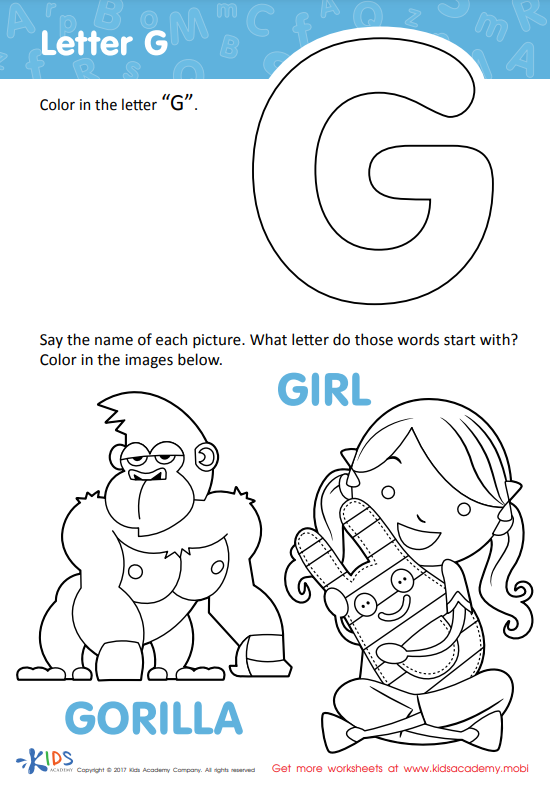-
English
-
English Pre-K
-
Unit 1: Early Literacy Skills
-
ABCs
- Pre-writing Activities
- Letter A
- Letter B
- Letter C
- Letter D
- Letter E
- Letter F
- Letter G
- Letter H
- Letter I
- Letter J
- Letter K
- Letter L
- Letter M
- Letter N
- Letter O
- Letter P
- Letter Q
- Letter R
- Letter S
- Letter T
- Letter U
- Letter V
- Letter W
- Letter X
- Letter Y
- Letter Z
-
Phonological Awareness
- Rhyming Words
- Letter Sounds B, C, D, and F
- Letter Sounds G, H, J, and K
- Letter Sounds L, M, N, and P
- Letter Sounds Q, R, S, and T
- Letter Sounds V, W, X, Y, and Z
- Letter Sounds A, E, and I
- Letter Sounds O and U
- Beginning Sounds
- Matching Letters to Sounds
-
ABCs
-
Unit 2: Vocabulary
-
Common Words
- Sorting Words into Categories
- Color Words
- Verbs and Adjectives
-
Sight Words
- Sight Words 'I' and 'Can'
- Sight Words 'You' and 'Like'
-
Common Words
-
Unit 3: Print Awareness
-
Parts of a Book
- Working with a Book
- Spaces Between Words
- Text and Illustrations
-
Picture Books and Poems
- Picture Book Text Features
- Poem Text Features
- Signs and Labels in the Community
-
Parts of a Book
-
Unit 4: Reading Literature
- Questions About Stories
- Discussing Stories
-
Unit 5: Reading Informational Texts
- Retelling Details in a Text
- Questions About a Text
- Connections Between Events
- Text Features
- Describing Illustrations
-
Unit 1: Early Literacy Skills
-
English Pre-K
-
Math
-
Math for Pre-Kindergarten
-
Logic and Geometry
-
Matching and Sorting
- Same and Different
- Which One Is a Little Different?
- Objects That Go Together
- Sorting by Color and Size
- Sorting The Same Group in Different Ways
- Patterns
-
Shapes
- Shapes in Our Environment
- Naming Shapes Regardless of Size
- Making Shapes in Preschool
- Comparing Shapes
- Relative Positions
- Sorting Shapes
-
Matching and Sorting
-
Early Number Sense
-
Numbers 1–5
- Counting to 3
- Counting to 5
- Arranging Objects up to 3 Objects
- Arranging up to 5 Objects
- Writing Numbers 1–5
-
Numbers 1–5
-
Numbers up to 10
- Counting to 10
- Arranging up to 10 Objects
- Number 0
- Writing Numbers 6–10
- Breaking Down Numbers 6-10
-
Logic and Geometry
-
Math for Pre-Kindergarten
Letter G
Now that the letter F is out of the way, we’ll be looking at the letter G. To ease the new letter into your child’s curriculum, try to first integrate it into their environments. One way to expose them to the letter visually by setting the letter of the week on a big board in their learning space. Other ways to do that is by starting to point out things in their daily routine that are related to the letter G. For example, give them a snack that starts with the letter G, like grapes, and point out the sound and name of the letter. Later you can officially introduce the letter by suggesting to watch this short Letter G video created by Kids Academy.
After your child is fully prepared, you can now move on to the fun part, the activities! Here is a list of five activities you can offer your child throughout the week to help them learn the letter G.
- Letter G Coloring Sheet: You can offer this worksheet as a first activity since it appeals to kids because of its simple yet artistic nature. It passively introduces the letter shape through coloring the letter G as well as the letter shape and sound through coloring images of words that start with this letter.

- Letter G Tracing Page: This activity utilizes the skill of tracing to familiarize the child with the shape of the letter G. In the first exercise of this worksheet, your child will build the necessary muscle memory to write the letter G correctly by first tracing it and eventually writing it independently. The second exercise demonstrates how this letter is used in words such as ‘guitar’ and ‘ghost’, emphasizing the sound the letter makes.

- Bubble G: Draw a big bubble letter G on a cardboard and give your child any object that starts with the letter G to glue inside of it such as gum wrappers. This activity also works on exposing the child to the shape of the letter first and foremost, in addition to the sound it makes in words that start with it.
- Grape Painting: The aims of this activity are very similar to the previous one, but some children might find this one more interesting. Here, your child will use grape halves as stamps to draw a letter G on paper using paint.
- Letter Baskets: This activity is designed to help your child differentiate between the uppercase and lowercase G. You’ll need two baskets and around 10 small balls, 5 with the capital letter G written on them and 5 with lowercase g. The objective of this activity is to put each ball in its corresponding basket, one labeled for lowercase and one for capital G. The added benefit of this exercise is that it motivates the child to do physical exercise, and a healthy body leads to a healthy mind.
In addition to their benefit in teaching the letter G, these activities will also offer your child the chance to practice their listening and speaking skills while you engage with them, as well as their pre-reading and pre-writing skills with the help of the worksheets provided.

